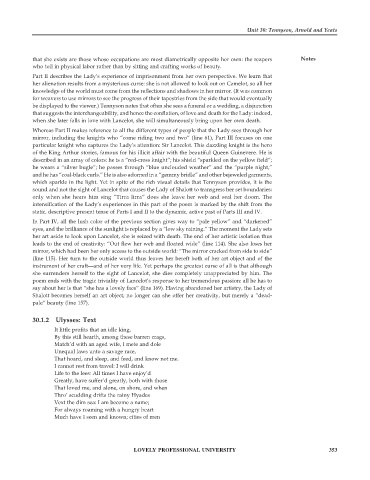Page 360 - DENG405_BRITISH_POETRY
P. 360
Unit 30: Tennyson, Arnold and Yeats
that she exists are those whose occupations are most diametrically opposite her own: the reapers Notes
who toil in physical labor rather than by sitting and crafting works of beauty.
Part II describes the Lady’s experience of imprisonment from her own perspective. We learn that
her alienation results from a mysterious curse: she is not allowed to look out on Camelot, so all her
knowledge of the world must come from the reflections and shadows in her mirror. (It was common
for weavers to use mirrors to see the progress of their tapestries from the side that would eventually
be displayed to the viewer.) Tennyson notes that often she sees a funeral or a wedding, a disjunction
that suggests the interchangeability, and hence the conflation, of love and death for the Lady: indeed,
when she later falls in love with Lancelot, she will simultaneously bring upon her own death.
Whereas Part II makes reference to all the different types of people that the Lady sees through her
mirror, including the knights who “come riding two and two” (line 61), Part III focuses on one
particular knight who captures the Lady’s attention: Sir Lancelot. This dazzling knight is the hero
of the King Arthur stories, famous for his illicit affair with the beautiful Queen Guinevere. He is
described in an array of colors: he is a “red-cross knight”; his shield “sparkled on the yellow field”;
he wears a “silver bugle”; he passes through “blue unclouded weather” and the “purple night,”
and he has “coal-black curls.” He is also adorned in a “gemmy bridle” and other bejeweled garments,
which sparkle in the light. Yet in spite of the rich visual details that Tennyson provides, it is the
sound and not the sight of Lancelot that causes the Lady of Shalott to transgress her set boundaries:
only when she hears him sing “Tirra lirra” does she leave her web and seal her doom. The
intensification of the Lady’s experiences in this part of the poem is marked by the shift from the
static, descriptive present tense of Parts I and II to the dynamic, active past of Parts III and IV.
In Part IV, all the lush color of the previous section gives way to “pale yellow” and “darkened”
eyes, and the brilliance of the sunlight is replaced by a “low sky raining.” The moment the Lady sets
her art aside to look upon Lancelot, she is seized with death. The end of her artistic isolation thus
leads to the end of creativity: “Out flew her web and floated wide” (line 114). She also loses her
mirror, which had been her only access to the outside world: “The mirror cracked from side to side”
(line 115). Her turn to the outside world thus leaves her bereft both of her art object and of the
instrument of her craft—and of her very life. Yet perhaps the greatest curse of all is that although
she surrenders herself to the sight of Lancelot, she dies completely unappreciated by him. The
poem ends with the tragic triviality of Lancelot’s response to her tremendous passion: all he has to
say about her is that “she has a lovely face” (line 169). Having abandoned her artistry, the Lady of
Shalott becomes herself an art object; no longer can she offer her creativity, but merely a “dead-
pale” beauty (line 157).
30.1.2 Ulysses: Text
It little profits that an idle king,
By this still hearth, among these barren crags,
Match’d with an aged wife, I mete and dole
Unequal laws unto a savage race,
That hoard, and sleep, and feed, and know not me.
I cannot rest from travel: I will drink
Life to the lees: All times I have enjoy’d
Greatly, have suffer’d greatly, both with those
That loved me, and alone, on shore, and when
Thro’ scudding drifts the rainy Hyades
Vext the dim sea: I am become a name;
For always roaming with a hungry heart
Much have I seen and known; cities of men
LOVELY PROFESSIONAL UNIVERSITY 353

